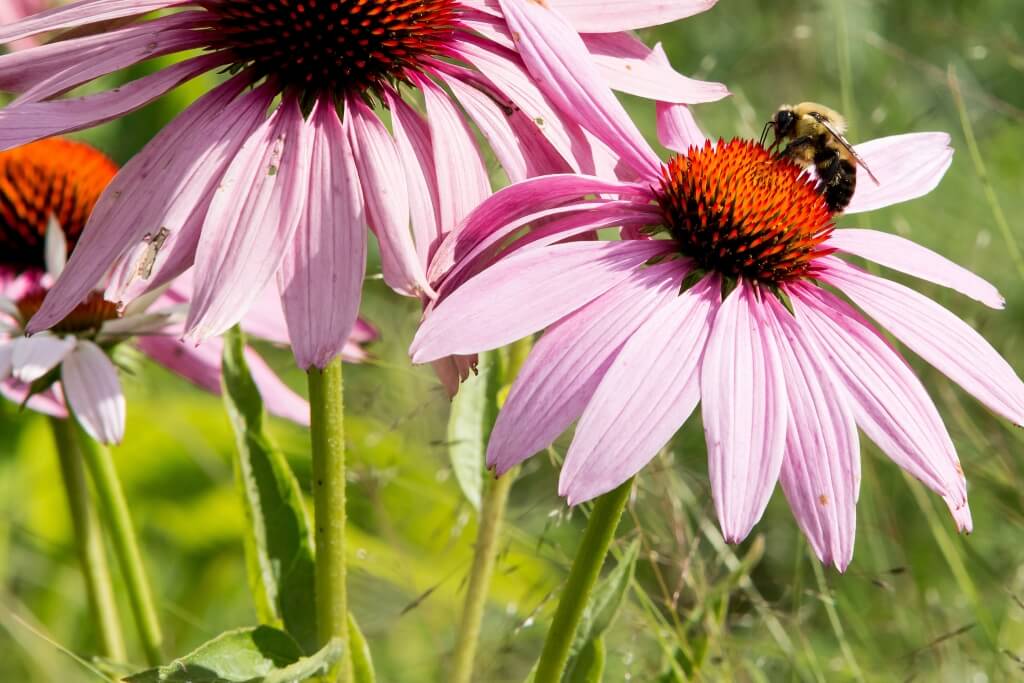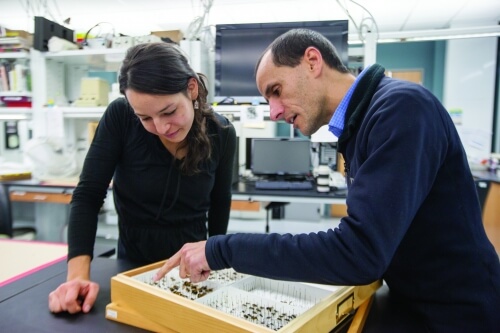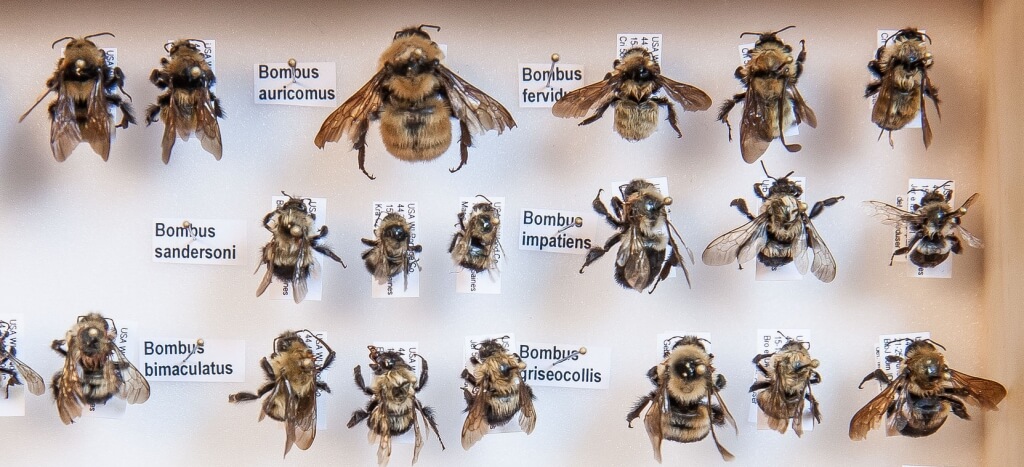UW scientists contribute to state’s Pollinator Protection Plan effort

Insects and pollinators working the gardens in front of Agricultural Hall on the UW–Madison campus. Sevie Kenyon/UW-Madison CALS
Wisconsin’s honey bees help support an $88 billion agricultural enterprise and play an important role in ecosystems throughout the state. But our bees face challenges. Wisconsin lost around 60 percent of its managed honey bee hives due to extreme cold and other factors during the winter of 2014. There is also evidence that some of our wild bees may be in decline, particularly a number of bumblebee species.
To help bolster Wisconsin’s pollinators, scientists at the Wisconsin Department of Agriculture, Trade and Consumer Protection (DATCP) and the University of Wisconsin–Madison developed the Wisconsin Pollinator Protection Plan, a document that provides information and recommendations designed to support pollinator populations around the state.
See pollinator tips for home gardens and lawns below
The plan offers practical advice for helping bees and other pollinators to a wide range of Wisconsin residents: homeowners and gardeners as well as farmers, land managers and others.
A draft of the plan was posted online today (Jan. 19). Public comments are being accepted through Feb. 19.

UW-Madison entomology professor Claudio Gratton and UW–Madison Research Associate Christina Locke worked with DATCP scientists and stakeholders to develop the Wisconsin Pollinator Protection Plan. James Runde/Wisconsin Energy Institute
“Wisconsin’s plan is among the first statewide plans that is both comprehensive in scope and developed with input from a broad array of stakeholders,” says UW–Madison research associate Christina Locke, who coordinated the effort to develop the plan and co-authored the plan document.
In May 2015, the federal government released a set of national guidelines to promote pollinator health. Even before then, states had begun developing their own plans. Wisconsin’s effort got underway in 2014 after DATCP secured a USDA Specialty Crop Block Grant for this purpose. At that point, DATCP reached out to Claudio Gratton, UW–Madison professor of entomology, to ask if he would be willing to be a partner in the process.
“I said, ‘Yes, absolutely.’ From my perspective, this is a really exciting way to take the science that we know and try to interface with public policy and promote the public understanding of science,” says Gratton, who is also a scientist with the Great Lakes Bioenergy Research Center.

A collection of some of the many insects known to be plant pollinators in the Department of Entomology. Sevie Kenyon/UW-Madison CALS
Gratton used the USDA funds to hire Locke, who had recently graduated from UW–Madison’s doctoral program in forestry. Locke’s role, a one-year position, involved coordinating the effort, including organizing meetings, communicating with the stakeholders involved in the process and assembling the plan document, while working closely with DATCP collaborators and fellow plan co-authors Elizabeth Meils, the state’s apiarist, and Michael Murray, manager of DATCP’s pesticide program.
The process of developing Wisconsin’s plan was notably inclusive and harmonious. Three stakeholder meetings were held to gather input from a wide variety of perspectives, including representatives from beekeeper businesses, environmental groups and agricultural interests. From the beginning, there was broad consensus that the state’s pollinators face a multifaceted problem that requires a multi-part solution.
“From my perspective, this is a really exciting way to take the science that we know and try to interface with public policy and promote the public understanding of science.”
Claudio Gratton
“This effort was not in response to a specific crisis event, which put us in a unique position to discuss pollinator issues in a positive environment. It was impressive to see the diversity of views coming together and having fruitful conversation without any one hot-button issue overwhelming the discourse,” notes Locke.
The front section of the plan gives a science-based overview of Wisconsin’s pollinators and the challenges they face. The second part has four sections of best management practices (BMPs), each tailored to a key audience of the plan: beekeepers, agricultural land managers, nonagricultural land managers and home gardeners.
Each section of BMPs provides a range of recommendations — from easy to difficult to implement — that can help pollinators. Many address expanding the quality and quantity of pollinator habitat and being careful about pesticide usage.
“You can do some relatively simple things and potentially have a big impact. It’s not like you need to transform the world in order to have an effect,” says Gratton.
For agricultural professionals, suggested practices range from using blooming cover crops when possible to leaving woody debris on field edges, which can provide nesting material for wild bees. The plan encourages homeowners to follow directions when using pesticides and to avoid spraying during bloom. Across the board, all groups can help by planting a mix of flowers in the landscape — along roadsides, field edges and in yards — that bloom all season long, providing an ongoing buffet of nutritious food for pollinators.
The plan is not meant to be a regulatory document. It is designed to help citizens of Wisconsin make better land, crop and garden management decisions with pollinator health in mind. The hope is that everybody’s actions will add up.
“Every little piece can help,” says Locke.
The draft of the Wisconsin Pollinator Protection Plan is available online, along with instructions for how to share feedback.
Pollinator-promoting tips for home gardens and lawns
- Plant a diverse array of flowers — in a variety of colors — that are suited to your yard.
- In addition to wildflowers such as milkweeds, zinnias and cosmos, many blooming garden herbs are great for pollinators, including mints, oregano, garlic, chives, parsley and lavender.
- Not all flowers attract pollinators. Some that have been highly modified by plant breeders don’t provide much pollen or nectar. Examples include most tulips, daffodils, petunias and ornamental roses.
- Create nesting spaces for native bees: Leave some areas in your yard undisturbed and messy, with bare soil, dead wood or leaf litter.
- Know which pesticides are harmful to pollinators and avoid applying these to flowering plants or to areas where pollinators may be nesting.
- Before applying insecticide to treat lawn pests, remove clover and dandelion blooms that might attract pollinators.
- If you discover a honey bee swarm (a colony looking for a new nest site) in your yard, ask a local beekeeper to help remove it.
Tags: agriculture, environment, research, wildlife




